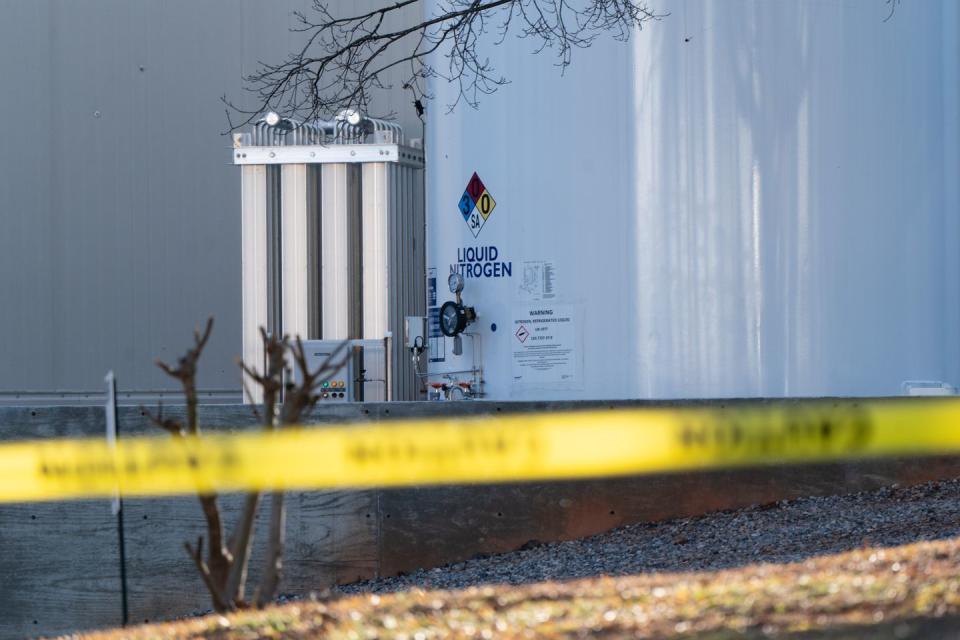Liquid Nitrogen Is Used in the Medical and Food Industries, But Mishandling It Can Become Deadly
A liquid nitrogen leak at a Foundation Food Group poultry plant in Gainesville, Georgia, killed six and injured 11 on January 28, 2021, according to the Associated Press.
At room temperature, liquid nitrogen vaporizes and expands into an odorless, colorless gas that can become deadly in poorly ventilated spaces.
Liquid nitrogen has a number of uses in the medical field, in scientific research, and in the food industry.
A liquid nitrogen leak at a Gainesville, Georgia poultry plant killed six people and injured nearly a dozen others last Thursday, the Associated Press reports.
If you're most familiar with liquid nitrogen from using it in seemingly harmless science experiments back in school, the tragic news may come as a shock. What is liquid nitrogen, anyway, and why is it so dangerous?
DIVE DEEPER ➡ Join Pop Mech Pro and get exclusive answers to your most pressing science questions, starting NOW.

What Is Liquid Nitrogen, and What Is It Used For?
Nitrogen gas makes up roughly 78 percent of Earth's atmosphere by volume, according to the Royal Society of Chemistry. The element, discovered in 1772 by Daniel Rutherford, is a critical building block of all life on Earth and plays a key role in plant growth. When cooled to -320 degrees Fahrenheit, the gas turns into an ultra-chilly liquid.
Polish professors Zygmunt Wróblewski and Karol Olszewski became the first to successfully liquify nitrogen in 1883. Just 15 years later, the British scientist James Dewar developed a storage canister for the substance, which served as a prototype for modern LN2 storage containers.
Many large-scale refrigeration systems, like those used at the Foundation Food Group plant, rely on liquid nitrogen as a coolant. Liquid nitrogen has become a popular coolant because it freezes nearly anything it touches. Today, the medical industry uses it to to preserve blood and reproductive cells, among other things, for storage in research laboratories and as a refrigerant in the food and beverage industry. (You may have used liquid nitrogen to freeze a wart off your body.)
The English culinary entrepreneur Agnes Marshall—dubbed the "Queen of Ices" by her Victorian-era London contemporaries—is credited with being the first to suggest the use liquid nitrogen in the kitchen. Many high-end restaurants now use small amounts of liquid nitrogen to instantly freeze food and enhance fancy cocktails. (But imbibe at your own risk: One British teen had to have her stomach removed after she ingested a cocktail that contained liquid nitrogen. Master mixologists are supposed to swish it around the glass until it completely vaporizes before pouring in the drink.)

When Does Liquid Nitrogen Become Dangerous?
Despite being a common coolant, mishandling liquid nitrogen can come with deadly consequences. When liquid nitrogen leaks into the air, it boils off into a colorless, odorless, and inert gas, which displaces oxygen in enclosed spaces.
Leaks, like the one that happened at the Foundation Food Group poultry plant last week, are particularly dangerous. When warmed up, liquid nitrogen vaporizes and expands, producing a large cloud of nitrogen gas that can displace oxygen in poorly ventilated rooms.
This can lead to headaches, dizziness, loss of consciousness, disorientation, and death by asphyxiation, according to Utah State University. And because the gas is odorless, colorless, and inert, there are often no warning signs that indicate a leak has occurred. Many succumb to their symptoms before they realize what is happening.
➡ Cool Stuff We Love: The Best Microscopes for Every Age
Last week's accident is just the latest in a slew of devastating cryogenic incidents. Fourteen people died from asphyxiation in liquid nitrogen-related incidents between 2012 and 2020, according to U.S. Occupational Safety and Health Administration (OSHA).
Liquid nitrogen can also cause tissue damage (read: frostbite) if exposed to bare skin for long periods of time. Curiously, as the Royal Institution shows in the below video, the Leidenfrost effect, in which the warmer substance is insulated against the freezing liquid by a cloud of vapor, can prevent cryogenic burns to some degree. It goes without saying, but we'll say it anyway: Do not try this at home.
Because liquid nitrogen has such a massive liquid-to-gas expansion ratio—meaning it expands by a factor of 694—vaporizing the liquid in an enclosed container can have catastrophic consequences. In 2006, an incident in a laboratory at Texas A&M University in College Station sent a liquid nitrogen tank shooting through the ceiling like a rocket. Fortunately, no one was hurt.
🎥 Now Watch This:
You Might Also Like

